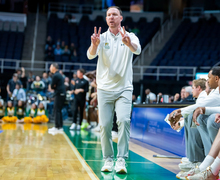McDonell: Kanye West highlights difficulties for celebrities in fashion industry
Kanye West said he’s cried over the idea of having his own clothing store.
“I dreamed, since I was a little kid, of having my own store where I could curate every shoe, sweatshirt and color,” he told the New York Times in an April 10 article.
This year he has received much acclaim for his line with Adidas, aspiring to bring forward-thinking clothes to the masses without the hefty price tag. However, his many other lines have been criticized, taking him a few steps back from his fashion goal and a big chunk out of his pocketbook. In The Times profile, West spoke about his heavily criticized 2012 clothing line, saying that the effort that he made actually put him in debt.
Much of Kanye’s problems were a result of those who had no interest in aiding his success — the designers who wouldn’t collaborate with him and the financiers who wouldn’t back him.
Getting fashion design businesses off the ground didn’t used to be this hard. Like most creative industries, plenty of designers from the baby boom generation, such as Tommy Hilfiger, Ralph Lauren and Calvin Klein, were children of working or middle-class parents. As high fashion changed from a craft to a business in the 1990s, it became harder for those without resources and capital to rise up.
West is just like many of the other small designers and celebrities who try to start up their own lines. For a ready-to-wear brand that uses fine materials, the samples they create of designs can cost upward of $100,000 alone a season.
West’s struggle was further advanced with skepticism and prejudice. Because while it could be argued that his celebrity status allowed for a line skipping of sorts, he told The Times it was more frequently an obstacle.
“Fame is often looked down upon in the design world, so it’s actually been something I had to overcome,” he wrote on Twitter when Fern Mallis, the creator of New York Fashion Week, told The New York Post that she was “kind of over Kanye.”
The one thing that’s cheaper these days is brand recognition because of the convenience of social media. But followers do not equal customers.
“I’ve come across brands that might have 150,000 followers on Instagram, but they’re still making less than $150,000 a year in sales,” said Ari Bloom of A2B Ventures, a strategic advisory firm that often counsels young designers, in a Sept. 19 Fashionista article.
Receiving design awards can help businesses to get off the ground, but it’s important to remember that a good chunk of the actual money that they are awarded goes to taxes. Most companies are not profitable until they reach $5 million to $10 million in sales, which can take years to actually achieve, Bloom said.
Sure, there are labels that are founded on less. Many designers do it by taking six-figure consulting jobs on the side and funneling that money back into the business. Others work out of their apartments, trying to keep the label afloat collection by collection. Crowdfunding has also become a new option that requires little effort, but it’s less practical for smaller designers who are making things at the contemporary and ready-to-wear levels.
So while it may take designers a while to get off the ground, labels like West’s prove that it can be done, just with a little patience, talent and money.
Alexis McDonell is a junior magazine journalism major. Her column appears weekly in Pulp. You can email her at admcdone@syr.edu.
Published on April 19, 2015 at 7:37 pm





